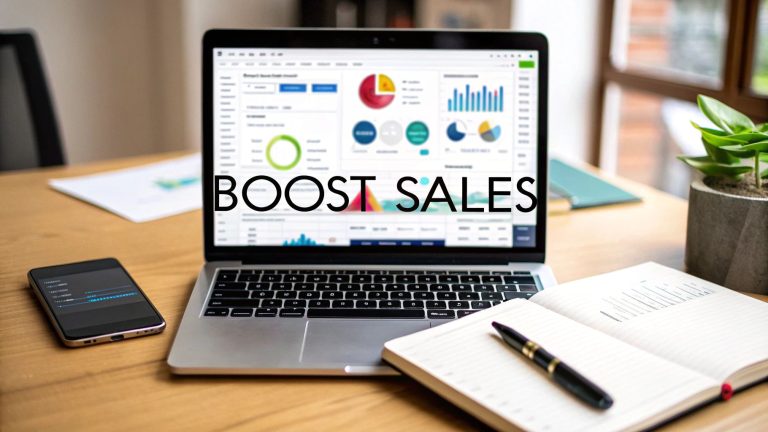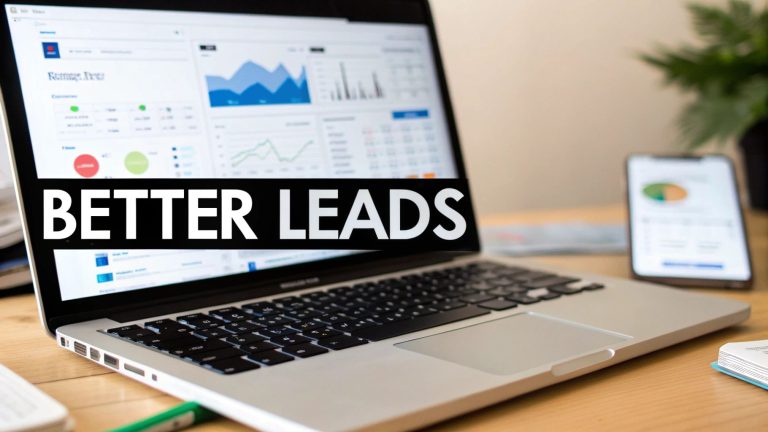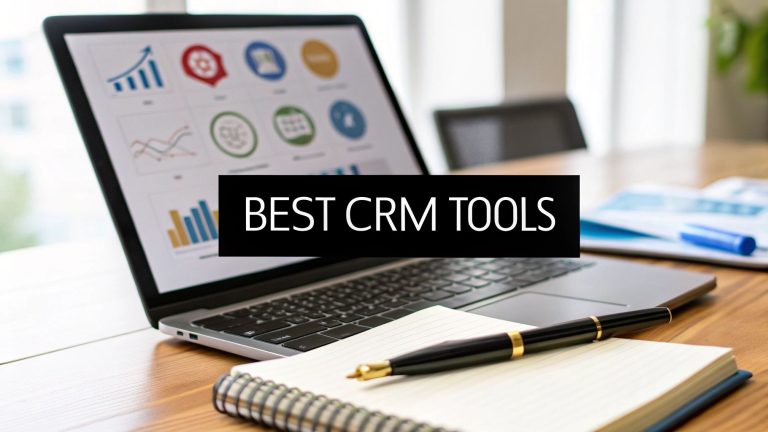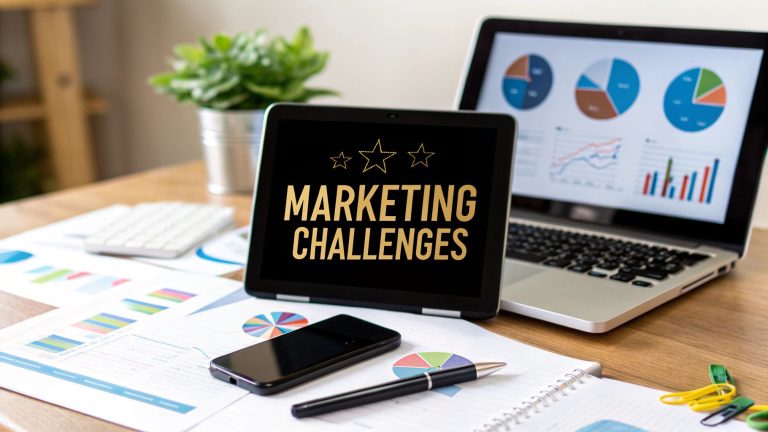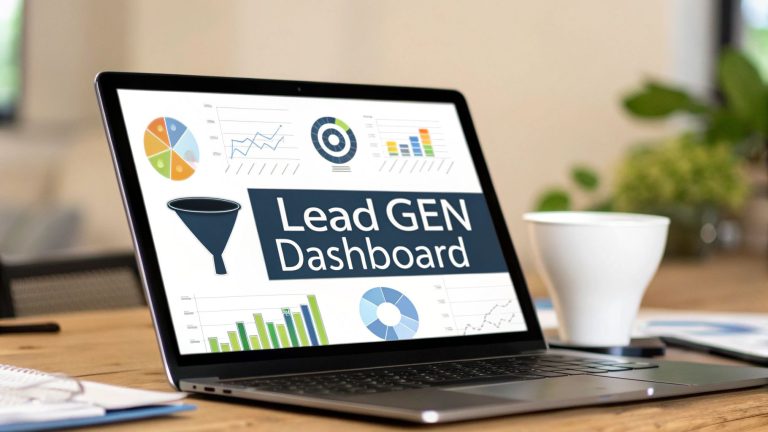Drive More Sales with Automotive Lead Generation
Think of your dealership like a magnet. Automotive lead generation is all about cranking up the power of that magnet to pull in car buyers from a seriously crowded digital marketplace. It’s the entire game plan for finding, connecting with, and walking potential customers from their first Google search right up to a test drive.
What Automotive Lead Generation Really Means Today
Not too long ago, getting leads meant you just had to wait. You waited for customers to wander onto the lot or maybe circle an ad in the local paper. That model is officially broken.
Today, the car buying journey starts online—often weeks or even months before someone even considers stepping into a showroom. In fact, nearly 90% of car buyers are doing heavy-duty online research before they even think about making a decision.
This massive shift means your dealership's success isn't just about its physical address anymore; it's about its digital footprint. A solid lead generation strategy is the engine that drives a modern dealership, feeding your sales team a steady stream of people who are actually ready to talk.
The Core Pillars of Modern Lead Generation
When you boil it down, a successful automotive lead gen system stands on three key pillars. Get these right, and you're on your way to building a sales pipeline you can actually count on.
- Attraction: This is the top of your funnel. It's all about grabbing the attention of potential buyers through channels like search engines, social media, and digital ads. You're basically putting your dealership in front of people who are actively looking for a vehicle.
- Conversion: Once you've got their attention, the next move is to turn that visitor into a real lead. This is where you convince them to hand over their contact info in exchange for something they find valuable, like a quick trade-in estimate or a side-by-side vehicle comparison guide.
- Nurturing: Getting a name and an email is just the start. Nurturing is how you build a relationship with that person. You send them helpful info at the right time and gently guide them toward booking that all-important appointment.
A lead isn't just a contact in a spreadsheet—it's a chance to start a real conversation. The point of automotive lead generation isn't just to hoard data; it's to create genuine connections that build trust and, ultimately, close deals.
Why Old Tactics No Longer Work
Just having a website and running a few generic ads won't cut it anymore. Today's customers expect a personal touch. They're used to the smart, tailored experiences they get from places like Amazon and Netflix, and they bring those same expectations to the car-buying process.
This means your strategy has to be proactive and driven by data. If you want to go deeper into the core principles, you can learn more about what is lead generation in marketing and see how it works across different fields. The goal is to meet customers where they are with the right message at the right moment, turning your marketing from a budget-eater into a revenue-generating machine.
Your Core Channels for High-Quality Leads
Figuring out where your best customers hang out online is the first step. You have to meet them on the digital roads they're already driving down, from Google searches to their social media feeds. A smart, multi-channel approach is the only way to make sure you're capturing serious buyers at every stage of their journey.
Think of each channel as a different tool in your toolbox. Some are for broad strokes, others for fine-detail work. Using several at once is how you build something that lasts.
To keep the sales floor busy, you need a steady stream of prospects flowing in. The data shows that most dealerships need around 100 to 150 qualified leads every month to hit their sales targets of 100 to 200 cars. And here's the kicker: digital marketing brings in a 70% higher lead volume than old-school advertising. It's not just an option anymore; it's essential.
Mastering Search Engine Optimization
SEO is your foundation. Plain and simple. It’s all about making sure your dealership shows up when a local customer types "best used cars near me" or "Honda dealership reviews" into Google. This isn't a quick fix; it's a long-term play to build real authority and trust.
When you do SEO right, your website becomes the go-to resource. By creating content that actually answers the questions people are asking—like model comparisons, financing explainers, or service tips—you attract visitors who are actively researching a purchase. You become the helpful expert they remember when it's time to sign the papers.
Your website is the single most important digital tool you have. That’s why using top strategies to build an effective lead generation website is so critical. A well-built site is your digital showroom, working around the clock to pull in and convert leads for you.
The image below breaks down automotive lead interest by generation, giving you a clear idea of where to aim your digital efforts.
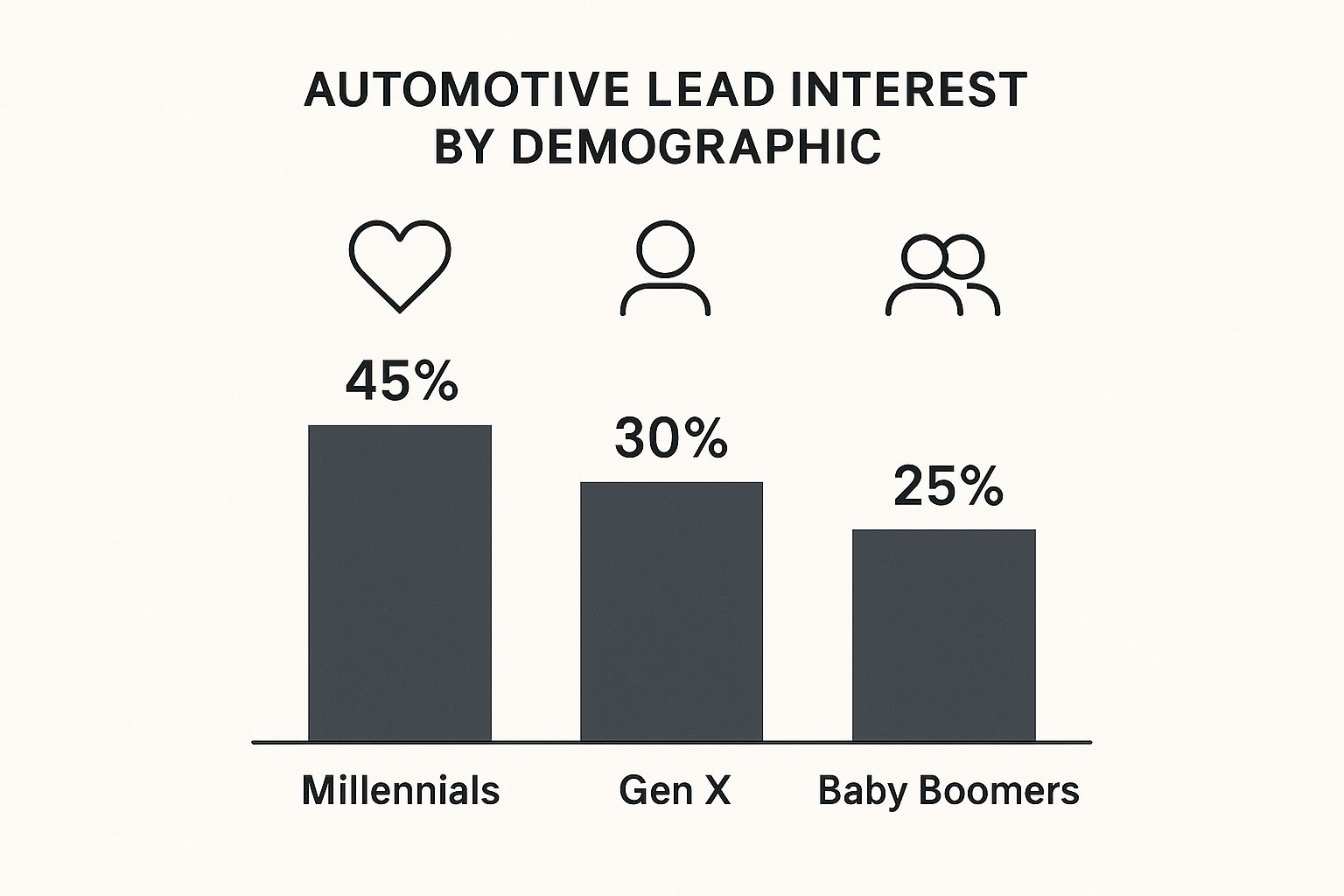
As you can see, Millennials are the biggest group of online car shoppers by a wide margin. That tells you that being digital-first isn't just a good idea—it's a necessity.
Leveraging Paid Advertising Precision
While SEO builds your long-term authority, paid advertising is how you get immediate, targeted traffic. Platforms like Google Ads and Facebook Ads let you zero in on in-market buyers with scary-good precision, targeting them based on their demographics, what they do online, and what they’ve shown interest in.
With paid search, you can jump to the very top of the results page for the most competitive keywords. This is perfect for grabbing the attention of people who are ready to buy right now.
Key Takeaway: Paid advertising is like hitting the nitrous button on your lead generation. It gives you a direct, measurable path to put your inventory and special offers right in front of the people most likely to buy.
Social media ads, especially Facebook Lead Ads, open up another massive opportunity. These ads let people submit their info with a pre-filled form right inside Facebook, making it ridiculously easy to become a lead. You can target users who just visited a car-buying site or even those who follow your competitors. To get the full scoop on this, check out our guide on car sales lead generation.
Choosing the right channel depends entirely on your dealership's goals, budget, and target audience. Here's a quick comparison to help you decide where to focus your efforts.
Comparing Top Automotive Lead Generation Channels
| Channel | Best For | Typical Cost Model | Key Advantage |
|---|---|---|---|
| SEO | Building long-term, organic traffic and brand authority. | Monthly Retainer/Project-Based | Sustainable, high-quality leads at a lower long-term cost. |
| Paid Search (PPC) | Capturing immediate, high-intent buyers actively searching. | Pay-Per-Click (PPC) | Fast results and precise targeting for bottom-of-funnel leads. |
| Facebook Lead Ads | Generating leads directly within the social media platform. | Cost-Per-Lead (CPL) or CPM | Low-friction for users; excellent for top-of-funnel engagement. |
| Third-Party Listings | Reaching a massive, aggregated audience of active shoppers. | Subscription/Per-Listing Fee | Puts your inventory in front of buyers already on marketplaces. |
Ultimately, the most powerful strategies blend these channels together. Use paid ads for quick wins while your SEO builds a strong foundation for the future.
Maximizing Third-Party and Owned Assets
Finally, a truly complete strategy pulls in leads from third-party marketplaces and makes the most of your own website's conversion tools.
- Third-Party Marketplaces: You have to be on giants like Autotrader or Cars.com. They attract a huge audience of active car shoppers, and listing your inventory there puts your vehicles right in their line of sight. It's a no-brainer.
- Owned Website Tools: Your website can't just be a pretty brochure; it needs to be an interactive lead-generating machine. By adding tools like trade-in value calculators, financing pre-approval forms, and "schedule a test drive" buttons, you give visitors something valuable in exchange for their contact info.
Creating Offers That Turn Clicks Into Customers

Getting someone to your website is just the opening move in automotive lead generation. A click is just a number. A lead, on the other hand, is a real person who trusts you enough to hand over their contact info. That critical exchange only happens when you offer them something valuable in return.
Think of it like a trade. Your classic "Contact Us" button just doesn't work anymore because it’s a one-way street—it offers zero immediate value to the buyer. To turn that anonymous website traffic into actual leads you can talk to, you need to dangle an irresistible offer, what we call a lead magnet, that solves a real problem for them.
The Psychology of an Irresistible Offer
A killer offer gets right inside the customer's head at the exact moment they need help. It’s not about what you want to tell them; it’s about what they’re desperate to find out. The best offers deliver instant answers or make a tough decision feel way easier.
For instance, someone just starting their car search is probably worried about what they can afford. A shopper narrowing down their final choices is hunting for hard data to feel confident. And someone who's ready to buy just needs a little nudge to choose your dealership right now. Each stage demands a different hook.
The big idea is simple: give away a helpful solution or a key piece of information in exchange for a name, email, and phone number. This simple trade is the bedrock of any solid lead capture strategy.
Crafting High-Converting Automotive Lead Magnets
It's time to think beyond the generic contact form. This requires a little creativity and a real feel for how people actually buy cars. Your entire goal is to match the perfect offer to the right person at just the right time.
Here are some of the most powerful lead magnets you can use in the auto industry:
- Instant Trade-In Value Estimates: This is the heavyweight champion. It answers the one question every car owner has: "What's my current car worth?" You're giving them a personalized, valuable number in seconds.
- Downloadable Vehicle Comparison Guides: Car shoppers are almost always stuck between two or three models. A simple, clean PDF that breaks down the specs, features, and true cost of ownership can instantly position you as the helpful expert they need.
- Exclusive New Inventory Alerts: Got a hot model coming in that's hard to find? Offer an "early access" list. This creates a feeling of being an insider and captures super-motivated buyers before they start shopping around.
- Financing Pre-Approval Forms: This one is aimed squarely at serious, ready-to-buy customers. It moves them way down the path to a purchase and hands your sales team a red-hot, qualified lead.
These kinds of offers turn a static webpage into a machine that actively generates conversations.
Matching the Offer to the Buyer Stage
Look, not everyone visiting your site is at the same point in their journey. A smart lead generation plan serves up different offers depending on what a visitor is doing. A one-size-fits-all approach always leaves money on the table.
Think about it with this simple framework:
- Top of Funnel (Awareness/Research): These folks are just gathering info. They're kicking tires, digitally speaking.
- Great Offers: "The Ultimate SUV Buyer's Guide," "An EV Charging Guide for [Your City]," or a "Checklist for Test Driving a Used Car."
- Middle of Funnel (Consideration): Now they're getting serious and comparing specific models.
- Great Offers: "Side-by-Side Comparison: Honda CR-V vs. Toyota RAV4," "Get an Instant Trade-In Estimate," or "Calculate Your Monthly Payment."
- Bottom of Funnel (Decision): These visitors are ready to pull the trigger and talk to a dealership.
- Great Offers: "Schedule a Test Drive," "Lock In This ePrice," or "Pre-Qualify for Financing in Minutes."
By sprinkling these different calls-to-action across your website—on your blog, on vehicle detail pages, and on dedicated landing pages—you create way more opportunities to turn a click into a real conversation. Every offer should feel like a helpful next step, not a hard sales pitch. That’s how you build trust and massively boost the number and quality of your leads.
Turning Raw Leads Into Sales-Ready Appointments

Getting a lead is just the starting whistle, not the finish line. The real work in automotive lead generation kicks off the second a potential buyer hands over their contact info. This is where you have to turn that flicker of interest into a real sales opportunity—a process we call lead nurturing.
Think of it this way: a new lead is like a seed. You can't just toss it on the counter and hope it sprouts. It needs the right amount of water, sunlight, and attention at just the right moments. In the same way, a lead needs consistent, valuable communication to build trust and coax them toward your showroom.
The Critical Need for Speed
In the car business, speed isn't just an advantage; it's everything. The moment a prospect fills out a form on your website, their interest is at its absolute peak. Every single minute that ticks by, that interest starts to cool. Waiting even an hour to respond can be the difference between booking an appointment and losing the sale to a faster competitor.
Response time is a make-or-break metric. Leads that get a follow-up within five minutes see dramatically better conversion rates. The pros use a mix of online and offline tactics, but the real secret weapon is a good CRM and solid lead tracking, which can boost conversion rates by up to 30% for sales teams. You can find more stats on how fast follow-ups impact car sales prospects in 2025.
This is where automation becomes your dealership's best friend. Tools like LeadSavvy Pro can instantly fire new leads from Facebook Lead Ads straight into your CRM or even a simple Google Sheet. That action triggers an immediate, automated follow-up, ensuring no lead ever goes cold.
Scoring Leads to Focus on the Hottest Opportunities
Let's be honest, not all leads are created equal. Some folks are just kicking tires online, while others are practically holding their wallets out, ready to buy. The challenge is figuring out who's who. If your sales team chases every lead with the same intensity, they'll burn out fast and miss the real opportunities.
This is where lead scoring comes into play. It's a straightforward but incredibly effective way to rank leads based on who they are and how they've engaged with you. By assigning points to different actions and details, you can build a clear priority list for your team.
Here’s a quick look at how you could set it up:
- High-Value Actions (+15 points):
- Submitting a financing pre-approval form.
- Requesting a trade-in appraisal.
- Directly asking to book a test drive.
- Medium-Value Actions (+5 points):
- Downloading a vehicle comparison guide.
- Viewing multiple pages for the same car model.
- Coming back to your site several times in a week.
- Key Demographics (+10 points):
- Lives within a 20-mile radius of your dealership.
- Has a credit profile that fits your financing partners' criteria.
With a simple scoring system, your sales team can see at a glance who's a "hot" lead (say, anyone over 25 points) and who's a "warm" lead that needs a bit more nurturing. It’s a data-driven approach that makes sure they're spending their time on calls that are most likely to turn into sales.
Nurturing with Automated Email and SMS Sequences
Once you know who your best leads are, the nurturing process begins. The goal is simple: stay top-of-mind without being annoying, and provide value with every touchpoint. Automated email and SMS drip campaigns are perfect for this.
Imagine a customer downloads your guide comparing two popular SUV models. Your automated system could kick off a sequence like this:
- Instantly: An email delivers the guide they asked for.
- Day 2: An SMS zips over with a link to a video walkaround of one of the SUVs.
- Day 4: An email lands in their inbox with customer testimonials for the other SUV.
- Day 7: A final SMS asks if they'd like to schedule a no-pressure test drive.
This keeps the conversation alive and answers questions they might have before they even ask. You're building a relationship by being helpful, not just pushy. By the time a salesperson actually picks up the phone to call, the lead is already warmed up. This is the bridge that connects marketing to sales, turning a name and number into a sales-ready appointment.
Measuring What Matters for Dealership Growth

So, are your marketing dollars actually turning into cars leaving the lot? It’s easy to get distracted by flashy numbers like clicks and impressions. But to get a real grip on your dealership's health, you need to look past the vanity metrics and measure what truly matters.
This is all about building a data-driven mindset, where every marketing decision is tied directly to your bottom line. When you track the right Key Performance Indicators (KPIs), you can pinpoint which channels are delivering a real return and which ones are just eating up your budget.
Cost Per Lead Is Just the Beginning
The first number most dealerships grab is the Cost Per Lead (CPL). It's a simple calculation: divide your total marketing spend on a channel by the number of leads it brought in. While it's a good starting point, CPL only tells a fraction of the story.
Let's be real—automotive lead generation is expensive. The average CPL is projected to be around $283 in 2025, which makes sense given the high value of a vehicle and the long, research-heavy buying cycle. You can find more insights about lead costs on amraandelma.com.
Because of this high cost, chasing the lowest CPL can be a huge mistake. A channel might bring in a flood of cheap leads, but if none of them ever buy a car, you've just wasted your money. The goal isn't just cheap leads; it's profitable customers, even if the initial CPL is a bit higher.
From Lead Count to Conversion Rate
This is where the Lead-to-Sale Conversion Rate comes in—a far more powerful metric. This KPI tells you exactly what percentage of your leads actually become paying customers. It's the ultimate litmus test for lead quality.
Key Insight: A high conversion rate is the clearest signal that your marketing is attracting the right people and your sales team is closing the deal.
Let's look at an example with two ad campaigns:
- Campaign A: Generates 100 leads at a CPL of $150.
- Campaign B: Generates 50 leads at a CPL of $250.
At first glance, Campaign A looks like the clear winner. But what if only one of its leads converts to a sale (a 1% conversion rate)? Meanwhile, five leads from Campaign B buy a car (a 10% conversion rate). Suddenly, the picture flips. Campaign B is wildly more profitable, despite its higher initial cost per lead. Our comprehensive guide digs into all the essential lead generation KPIs your dealership should be tracking.
The Ultimate Metric: Customer Acquisition Cost
The final piece of the puzzle is your Customer Acquisition Cost (CAC). This is the total cost of sales and marketing it takes to get one single customer to sign on the dotted line. It connects your ad spend directly to a closed deal, giving you a crystal-clear view of profitability.
The math is simple:Total Sales & Marketing Costs ÷ Number of New Customers Acquired = CAC
Once you know your CAC for each channel, making smart budget decisions becomes second nature. You can confidently double down on channels that deliver customers at a profitable cost and pull back from those that don't. This metric transforms your marketing from a cost center into a predictable, revenue-generating engine, ensuring every dollar you spend is truly driving dealership growth.
When you look at the road ahead for automotive lead generation, one thing is crystal clear: standing still is not an option.
The future isn’t about replacing the human touch at your dealership. It's about amplifying it with smarter tools and meeting customers where they are. The dealerships that will win in the coming years are the ones who lean into the tech that creates a more personal, streamlined buying journey.
And this isn't some far-off trend. The global lead generation market is on track to hit USD 6.38 billion by 2025, growing at a steady 8.3% clip each year. That number tells a story: businesses everywhere are doubling down on digital to keep up with what buyers now expect. You can get the full scoop on these trends by checking out the latest lead generation statistics on market.us.
The Rise of Artificial Intelligence
AI is quickly moving from an industry buzzword to a must-have in the dealership toolkit. Think of it this way: AI-powered systems can analyze your lead data to predict who is most likely to buy and when, letting your sales team focus their energy on hot prospects instead of chasing cold trails.
Then there's conversational AI. Modern chatbots are no longer the clunky, frustrating bots of the past. They can now provide 24/7 support on your website, answer surprisingly complex questions, schedule test drives, and qualify leads while your team is at home. They're your tireless front line, making sure no opportunity ever slips through the cracks.
The Big Picture: AI isn't here to take over jobs. It's an "always-on assistant" that handles the repetitive, time-sucking tasks, freeing up your team to do what they do best—build relationships and sell cars.
Immersive Experiences and New Ownership Models
More and more of the car buying journey is happening online before a customer ever steps foot in your showroom. Video is no longer just a nice-to-have; it's a primary way to engage those online-first buyers. The goal is to create immersive experiences that bring the showroom to them.
Here's what's working right now:
- Virtual Walkarounds: Sending detailed video tours of specific vehicles on your lot directly to a prospect.
- Live-Streamed Test Drives: Hopping on a live video call to walk a customer through a car, answering their questions in real-time.
- User-Generated Content: Encouraging new owners to post about their awesome experience on social media (and tagging you, of course!).
On top of that, the industry's big shift toward Electric Vehicles (EVs) and new ownership models like subscriptions is opening up brand-new lanes for lead generation. Think about it: creating content that educates people on EV charging, battery life, or maintenance costs will be a huge magnet for this new wave of buyers.
These aren't small changes. They demand a forward-thinking game plan, one that equips you to not just compete but to lead the pack in the next era of car sales.
Got Questions? We've Got Answers
Even with the best game plan, a few questions always pop up when you're rolling out a new automotive lead generation strategy. Here are some of the most common ones we hear from dealership managers and marketers, along with some straight-up answers.
How Much Should We Really Be Spending on Lead Generation?
There's no magic number here. Your budget depends entirely on your market, your sales targets, and the channels you're using.
Instead of picking a number out of thin air, work backward from your Customer Acquisition Cost (CAC). Figure out how much you can afford to spend to bring in a new customer while still making a profit. Then, pour your budget into the channels that hit that CAC sweet spot.
And remember, the average cost per lead (CPL) in the auto industry hovers around a steep $283. Don't get fixated on finding the cheapest lead. The real win is finding the channels that deliver leads that actually turn into sales.
How Fast Do I Need to Follow Up with a New Lead?
Right now. Seriously. The absolute golden window is within the first five minutes.
The second someone hits "submit" on your form, their interest is at its peak. If you wait even half an hour, your chances of ever connecting with them—let alone booking an appointment—drop off a cliff.
The Big Takeaway: Speed-to-lead isn't a suggestion; it's a requirement. You need automated systems that fire off an instant text or email. This guarantees every single lead gets an immediate touchpoint, even if your entire sales team is tied up. This one move can radically improve your conversion rates.
What’s the Difference Between a Lead and a Prospect Anyway?
Getting this right is key to making your sales process a whole lot smoother. Think of it as a journey.
- A lead is anyone who's raised their hand. They've shown a flicker of interest by giving you their contact info—maybe they downloaded an e-book or used your trade-in calculator. They're at the very top of your funnel.
- A prospect is a lead you've qualified. They're ready for a real sales conversation. They've sent stronger buying signals, like asking for a price on a specific VIN or checking its availability.
A good lead scoring system helps your team tell the difference instantly. It stops them from wasting time on tire-kickers and lets them focus all their energy on people who are getting close to a decision.
Ready to stop downloading CSV files and start closing deals faster? LeadSavvy Pro automates your entire Facebook lead capture process, pushing new leads straight into your CRM or a Google Sheet in real-time. Sign up for a free plan and see how it works.



